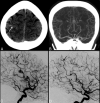Reversible Cerebral Vasoconstriction Syndrome, Part 1: Epidemiology, Pathogenesis, and Clinical Course
- PMID: 25593203
- PMCID: PMC7964694
- DOI: 10.3174/ajnr.A4214
Reversible Cerebral Vasoconstriction Syndrome, Part 1: Epidemiology, Pathogenesis, and Clinical Course
Abstract
Reversible cerebral vasoconstriction syndrome is a clinical and radiologic syndrome that represents a common presentation of a diverse group of disorders. The syndrome is characterized by thunderclap headache and reversible vasoconstriction of cerebral arteries, which can either be spontaneous or related to an exogenous trigger. The pathophysiology of reversible cerebral vasoconstriction syndrome is unknown, though alterations in cerebral vascular tone are thought to be a key underlying mechanism. The syndrome typically follows a benign course; however, reversible cerebral vasoconstriction syndrome may result in permanent disability or death in a small minority of patients secondary to complications such as ischemic stroke or intracranial hemorrhage.
© 2015 by American Journal of Neuroradiology.
Figures



References
-
- Ducros A. L37: reversible cerebral vasoconstriction syndrome—distinction from CNS vasculitis. Presse Med 2013;42(4 pt 2):602–04 - PubMed
-
- Ducros A, Bousser MG. Reversible cerebral vasoconstriction syndrome. Pract Neurol 2009;9:256–67 - PubMed
-
- Gupta S, Zivadinov R, Ramasamy D, et al. . Reversible cerebral vasoconstriction syndrome (RCVS) in antiphospholipid antibody syndrome (APLA): the role of centrally acting vasodilators—case series and review of literature. Clin Rheumatol 2014;33:1829–33 - PubMed
-
- Sheikh HU, Mathew PG. Reversible cerebral vasoconstriction syndrome: updates and new perspectives. Curr Pain Headache Rep 2014;18:414. - PubMed
Publication types
MeSH terms
LinkOut - more resources
Full Text Sources
Medical
